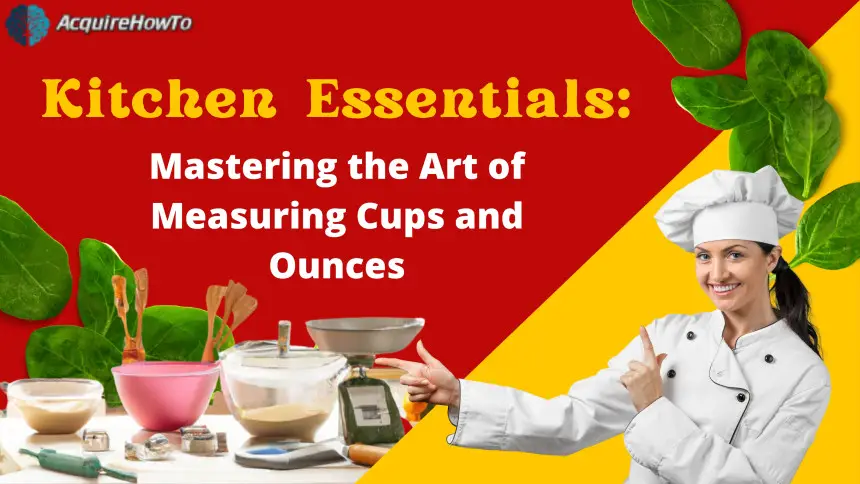
Kitchen Essentials: Mastering the Art of Measuring Cups and Ounces
"Unlock the culinary world's secrets with Kitchen Essentials: Mastering the Art of Measuring Cups and Ounces. Discover precision in every recipe with expert tips and techniques for accurate measurements. Elevate your cooking game today!"
Introduction
Are you sick of "pinch" and "handful" recipes? Precision in the kitchen replaces guessing measurements. In "Kitchen Essentials: Mastering the Art of Measuring Cups and Ounces," we explore proper cooking and baking with cups and ounces.
Whether you're a professional chef or a home cook, exact measurements are essential to tasty outcomes. Mastering cups and ounces can make all the difference when converting recipes and scaling supplies.
We'll cover measuring cups, their applications, and how to measure dry and liquid components in this complete guide. You'll learn how to use measuring cups correctly and get recommendations for accurate measurements.
Join us as we discover the secrets to excellent recipes and improve your cooking and baking talents. With cups and ounces, you can avoid kitchen mistakes and master cooking.
Importance of accurate measurements in cooking
Any successful recipe starts with accurate measurements. For the best flavour and texture, use the proper amount of each ingredient when baking a cake or cooking a savoury meal. Your recipes may fail or turn out radically different without accurate measurements.
Accurate measurements assure dish consistency and are crucial to cooking science. Certain chemical reactions require precise constituent proportions, and deviations can be disastrous. Mastering cups and ounces lets you control your cooking and make wonderful meals every time.
Baking requires even more precise measures. The science of baking requires precise ratios and proportions. A dense cake or overspread cookies can come from using too much flour or sugar. Accurate measurements are essential for bakery-quality outcomes.
It's not just baking that requires precise measurements. The appropriate flavour balance is vital for sauces, soups, and stir-fries. A dish can taste very different with too much salt or too little spice. You can assure perfect seasoning and excellent foods by using measuring cups and ounces.
After understanding the necessity of proper measurements, let's explore cups and ounces.
You may also like : "Golden and Crispy: Unveiling the Ultimate French Toast Recipe"
Different types of measuring cups and their uses
For specific uses, measuring cups exist in different shapes, sizes, and materials. Understanding measuring cups and their applications will help you choose the proper one.
- Liquid Measuring Cups: For measuring liquid substances, these cups often feature a spout. They commonly hold 1, 2, or 4 cups. Choose cups with clear, easy-to-read measures on the side.
- Dry Measuring Cups: Flour, sugar, and cocoa powder are measured in dry cups. They have flat tops for accurate levelling, unlike liquid measurement cups. They are 1/4, 1/3, 1/2, and 1 cup.
- Nesting Measuring Cups: These cups fit together for storage. The sizes range from 1/4 cup to 1 cup. These cups work for liquid and dry components.
- Measuring Spoons: Spices, baking powder, and vanilla essence are measured with measuring spoons. Sets normally comprise 1/4 teaspoon, 1/2 teaspoon, 1 teaspoon, and 1 tablespoon.
After discussing measuring cups, let's convert cups, ounces, and grammes.
Converting between cups, ounces, and grams
Converting cups, ounces, and grammes is useful in the kitchen. It converts recipes across measuring systems and adjusts serving sizes. Common conversions to remember:
- 1 cup = 8 fluid ounces = 16 tablespoons = 48 teaspoons
- 1 fluid ounce = 2 tablespoons = 6 teaspoons
- 1 tablespoon = 3 teaspoons
- 1 ounce = 28 grams
- 1 pound = 16 ounces = 454 grams
Note that ingredient conversions may change when converting cups and ounces or grammes. Due to density variances, flour and sugar conversions may change.
For accurate cup-to-ounce or gramme conversions, use a kitchen scale. Set your measuring cup to zero on the scale and add the necessary amount of ingredient until you reach the desired weight.
After conversions, let's prevent measuring cup blunders.
Common measuring cup mistakes to avoid
A measuring cup may appear simple, but there are several frequent blunders that can lead to erroneous measurements. Avoid these mistakes to ensure recipe success:
- Packaging Ingredients: Don't pack dry ingredients like flour or brown sugar into the measuring cup. Pour the ingredient into the cup and level it with a straight edge for exact measures. Packing too much ingredient can make the product denser or sweeter.
- Eyeballing Measurements: For precise measurements of salt and spices, use a measuring spoon. Eyeballing can cause flavour discrepancies and dish imbalance.
- The Wrong Measuring Cup: Using the wrong measuring cup can also cause inaccurate measures. A liquid measuring cup for dry materials can result in too much or too little. Always use the right measuring cup for the ingredient.
Avoid these blunders to ensure exact measurements and flawless recipes every time.
After learning how to avoid measuring cup problems, let's discuss measuring liquids and dry components.
Tips for measuring liquids and dry ingredients accurately
Both liquid and dry materials need precise measurements. Tips for precisely measuring liquids and dry ingredients:
Measuring liquids:
- Use a Liquid Measuring Cup: Use a spouty liquid measuring cup for convenient pouring. To measure accurately, place the cup on a flat surface and read at eye level.
- Fill to the Mark: Slowly pour liquid into the measuring cup and stop when it reaches the mark. For accurate measurements, check the meniscus bottom.
- Avoid Overpouring: Pour the liquid slightly below the desired measurement and add more in gradual increments until you achieve the exact amount.
Measure Dry Ingredients:
- Fluff and Spoon: Break up clumps in dry ingredients with a fork or whisk before measuring. For exact measurements, scoop the ingredient into the measuring cup and level it with a straight edge.
- Avoid Shaking or Tapping: Shaking or tapping the measuring cup can condense dry materials and cause erroneous measurements.
- Sift When Necessary: To achieve accurate and consistent results, sift clumping substances like flour or powdered sugar before measuring.
Following these tips will ensure exact measurements and great recipes every time.
After covering accurate measurement tips, let's review kitchen measuring tools.
You may also like : "A Nutritious Addition to Your Diet Green apples have several health benefits, one of which is weight loss."
Essential measuring tools for your kitchen
In addition to measuring cups, various kitchen measuring instruments are useful. Add these vital measurement instruments to your culinary arsenal:
- Kitchen Scale: Precise measures, especially for baking, require a kitchen scale. It measures substances by weight, which is more accurate than volume. Look for a scale with a tare function to zero out container weight.
- Measuring Spoons: Spices, baking powder, and vanilla essence require modest amounts of measuring spoons. Make sure your measuring spoons are sturdy and easy to clean.
- Measuring Jug: A measuring jug can measure liquid and dry substances. A jug with clear markings and a pleasant handle makes pouring easy.
- Digital Thermometer: Food safety requires testing the interior temperature of cooked meats with a digital thermometer. Look for an accurate thermometer with a probe long enough to reach the meat's centre.
- Timer: A timer is vital for precision cooking and baking, but not a measurement tool. A timer will assist you avoid overcooking or undercooking whether boiling a sauce or baking a cake.
These fundamental measurement instruments will help you confidently tackle any recipe in the kitchen.
After covering the key measurement equipment, let's measure baking materials.
How to properly measure ingredients for baking
Baking is precise and requires proper measurements to succeed. Measure baking materials accurately with these tips:
Dry Ingredient Measurement:
- Use the Spoon and Level Method: When measuring dry ingredients such as flour, spoon the ingredient into the measuring cup and level it off with a straight edge. Avoid scooping the ingredient directly from the container, as it can lead to compacted measurements.
- Avoid Shaking or Tapping: After spooning the dry ingredient into the measuring cup, don't shake or tap it to level. This can condense measures. Instead, level the component using a straight edge.
- Sift When Necessary: To achieve accurate and consistent results, sift clumping substances like flour or powdered sugar before measuring. Sifting breaks out clumps and aerates ingredients for accurate measures.
Measure Liquid Ingredients:
- Use a Liquid Measuring Cup: Use a spouty liquid measuring cup to pour liquid components. To measure accurately, place the cup on a flat surface and read at eye level.
- Pour Slowly: Avoid overpouring by slowly pouring liquid into the measuring cup. Stop pouring when the liquid reaches the specified mark and check the meniscus bottom for accurate readings.
Following these recommendations will ensure proper baking measurements and flawless masterpieces every time.
After covering baking ingredient measurement, let's compare measuring cups and kitchen scales.
Measuring cups vs. kitchen scales: Which is better?
In the culinary industry, measuring cups and kitchen scales are often debated. The benefits and downsides of each tool depend on personal preference and the recipe.
Cups for measuring:
- Pros: Most kitchens include measuring glasses. They measure liquid and dry ingredients and are used in regular cookery. Measurements cups are handy for measuring big amounts of materials.
- Cons: Measuring cups are less accurate than kitchen scales for dry materials. Recipes can be inconsistent due to ingredient density affecting measurement accuracy.
Kitchen Scales:
- Pros: Kitchen scales offer precise quantities, particularly for dry materials. These allow weight measurements of ingredients, which are more exact than volume measures. Precision baking requires kitchen scales for consistency.
- Cons: Kitchen scales are mostly used for weighing items, so they are less adaptable than measuring cups. They use batteries or electricity and may take up more storage space than measuring cups.
Having measuring cups and a scale in the kitchen is helpful. A kitchen scale is crucial for precision baking and accurate measurements, while measuring cups are perfect for everyday cooking and larger quantities.
After discussing measuring cups and kitchen scales, let's offer some top brands and products for measuring cups and ounces.
Conclusion: Mastering the art of measuring cups and ounces
All measuring cups are not made equal. Different measuring cups serve different functions. Examine some of the most prevalent types:
- Spout-topped Liquid Measuring Cups: These cups measure water, milk, and oil. Clear markings make them easy to read in 1-cup, 2-cup, and 4-cup sizes.
- Dry Measuring Cups: Measure flour, sugar, and spices with these cups. Their sizes range from 1/4 to 1 cup. Dry measuring cups have a smooth surface, so you can level ingredients for accurate measurements.
- Measuring Spoons: Baking soda, salt, and vanilla extract must be measured precisely with measuring spoons, which are not cups. Sets of 1/4 teaspoon to 1 tablespoon are usual.
Now that you know the different measuring cups, let's learn how to measure dry and liquid ingredients.
You may also like : "Cook, Eat, Repeat: Elevate Your Cooking Game with Delectable Spaghetti Squash Dish"
FAQs
How do I convert between cups and ounces?
- To convert cups to ounces, multiply the number of cups by 8 (since 1 cup equals 8 fluid ounces).
Can I use a regular cup for measuring dry ingredients?
- It's best to use dry measuring cups for accuracy, as regular cups may have varying sizes.
What's the difference between a liquid measuring cup and a regular glass?
- Liquid measuring cups have a spout for precise pouring, while regular glasses lack this feature.
Why is measuring by weight more accurate than using cups?
- Measuring by weight eliminates variations due to ingredient density, ensuring precision.
Can I substitute measuring spoons with regular spoons?
- While you can use regular spoons in a pinch, measuring spoons offer standardized accuracy.
What should I do if my recipe uses metric units, and I only have imperial measuring tools?
- Use conversion tables or online converters to switch between metric and imperial measurements accurately.
Tags
Cooking measurement tools, Essential kitchen measuring tools, Accurate measuring cups, Precision measuring in the kitchen, Kitchen measurement mastery, Measuring cups and ounces guide, Cooking with precision, Baking measurement essentials, Cooking accuracy tips, Kitchen measuring techniques, Measuring for cooking perfection, Kitchen measurement skills, Cooking with precision instruments, Mastering culinary measurements, Cooking with measuring cups, Baking precision tools, Accurate kitchen measurements, Kitchen measurement mastery tips, Measuring ingredients like a pro, Kitchen measurement equipment, Cooking with precision utensils, Precision in the kitchen, Mastering culinary measuring, Kitchen measuring cup techniques, Baking with accurate measurements





